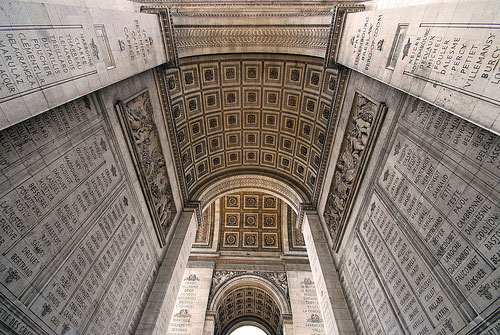Few things know about the Arc de Triomphe
Before becoming the symbol of France, the Arc de Triomphe stood on the land of "watching" to build a three-story elephant-shaped building.
"Giant elephant"
The land to build the current Arc de Triomphe had been "watched" by architect Charles Ribart as the site of a three-story elephant-shaped building. As expected, inside the building is a spiral staircase, leading to the door in the elephant's abdomen. The interior is designed with a wall and there is also a water line facing up to the faucet. However, the government rejected Ribart's proposal, so that the Arc de Triomphe had a chance to appear.
Born under Napoleon Emperor
By 1806, the idea of the Triumphal Arch was born after the victory in the Three Kings Battle at Austerlitz (now Slavkov u Brna of Czech Republic). Napoleon decided to build on Étoile square a project to honor French soldiers during the war.
He undertook the task of designing the Arc de Triomphe as architect Jean-Francois-Thérèse Chalgrin, followed by Louis-Robert Goust and Jean-Nicolas Huyot. His manuscripts are inspired by ancient works. The Arc de Triomphe is 50m high, 45m wide, consists of 4 cylindrical columns, each representing a victory. Above these pillars are large and small reliefs. The four largest sculptures are Army, Khai Hoan, Resistance and Peace. The inside of the four pillars is decorated with reliefs depicting famous battles.

Inside the Triumphal Arch, the name of 558 was engraved under Napoleon, the words underlined by the generals killed.(Photo: Travel Feeder).
When Napoleon abdicated in 1814, this work was suspended for several years and continued to be built in 1826. On July 29, 1836, 30 years after Emperor Napoleon ordered construction to begin, Khai Hoan New subjects were inaugurated.
In 1840, Napoleon's corpse was passed here before returning to the Invalides. The noble writer Victor Hugo was also able to leave one night before bringing it to Panthéon.
Anonymous martyrs
The Arc de Triomphe was also the resting place of an unknown soldier who died in the Battle of Verdun between France and Germany in World War I. The tomb was built on 11/11/1920. On the grave is the inscription: "This is the resting place of a French soldier sacrificing for his country".

The anonymous martyr's grave area is surrounded by barriers, many tourists still place memorial garlands when visiting.(Photo: istock).
From 1923 until now, a fire was lit on that grave every afternoon to honor those who fell for their homeland. In 1940, when the German army occupied Paris, this activity was still carried out under German permission.
Witness history
Many historical events took place before the Arc de Triomphe. Former French President Charles De Gaulle escaped death when he was assassinated here while in office. In 2002, another former president, Jacques Chirac, also nearly hit a bullet at this famous site.
Today's Arc de Triomphe
This famous icon is known to many visitors and attracts more than a million visitors. Admission is 12 euros. Guests will visit for free on the first Sunday in the month (from November 1 to March 31 every year).
In addition, the relics area is also free of entrance tickets for people under 18, EU citizens under 26 years old, primary and secondary teachers (except when there are exhibitions), people with disabilities and accompanying people, people seeking jobs and recipients of French government grants.
The process of preserving this building is not an easy task. The first time this place was maintained and repaired in 2011 and the French government still has no plans for the next remodeling.
- Bad things always remember longer than good
- 12 horrible things about China you may not know
- Impressive architectural works in Korea
- 10 interesting things about life you may not know
- 9 things are more important than money
- 10 interesting things about nature you may not know
- See the beauty of famous landmarks from a high angle
- Women do many things at the same time better than men
- Why do teenagers do foolish things?
- Things you don't know yet
- 10 interesting things about cats
- 10 interesting things about the Internet that you don't know
 'Fine laughs' - Scary and painful torture in ancient times
'Fine laughs' - Scary and painful torture in ancient times The sequence of numbers 142857 of the Egyptian pyramids is known as the strangest number in the world - Why?
The sequence of numbers 142857 of the Egyptian pyramids is known as the strangest number in the world - Why? History of the iron
History of the iron What is alum?
What is alum?